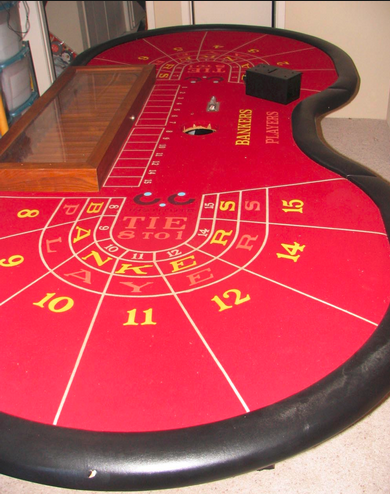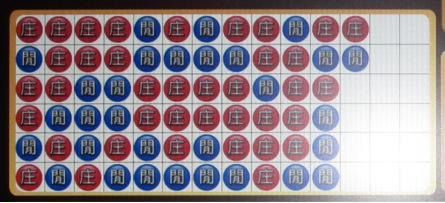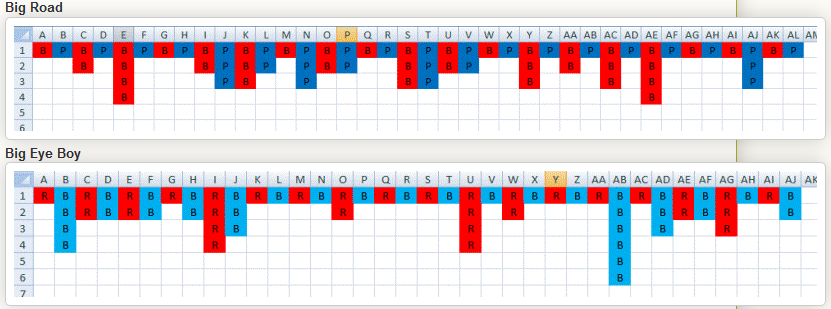baccarat statistics
Introduction
Baccarat is a game steeped in superstition. The vast majority of players keep careful track of the shoe history, either on paper or with the aid of screens that show every hand since the shoe began. There are various ways of recording this information. The companies that market the screens that display the shoe history present it in various ways, according to the most popular methods of trying to define patterns.
Baccarat is a game steeped in superstition. The vast majority of players keep careful track of the shoe history, either on paper or with the aid of screens that show every hand since the shoe began. There are various ways of recording this information. The companies that market the screens that display the shoe history present it in various ways, according to the most popular methods of trying to define patterns.
Before going further, let me give my usual comment on notation. When referring to an actual bet, I use capital letters. When referring to the player playing the game, I use lower case. I invite the rest of the world to follow this convention, to help avoid confusion.
For those who don't know me, let me take a moment to say that all this effort at trying to predict the next hand is a waste of time. For all practical purposes, the odds are the same for every hand, and the past history does not matter. Now before the perfectionists out there write to me, yes, I know if you had the use of a computer, a card counter could make computer-perfect decisions according to the composition of the remaining cards, which would very rarely result in an advantage on some bets. However, that is not what I'm talking about it. I'm saying that trying to find a pattern in past Player and Banker wins is as useless as predicting the next color in roulette (on a fair wheel) according to past reds and blacks.
For those who don't know me, let me take a moment to say that all this effort at trying to predict the next hand is a waste of time. For all practical purposes, the odds are the same for every hand, and the past history does not matter. Now before the perfectionists out there write to me, yes, I know if you had the use of a computer, a card counter could make computer-perfect decisions according to the composition of the remaining cards, which would very rarely result in an advantage on some bets. However, that is not what I'm talking about it. I'm saying that trying to find a pattern in past Player and Banker wins is as useless as predicting the next color in roulette (on a fair wheel) according to past reds and blacks.
Although I personally don't play baccarat, I have wondered for years about some of the tables in those displays of the shoe history. The staff at the Venetian has been very helpful in helping me understand, so that I may enlighten the rest of the world. So, with the introductions out of the way, let's get started. Here is a picture of a typical sign, seen at the Venetian. There are various components of display, which I will address individually.
bead plate
This section above is called the "bead plate." It used to be that players could buy a tray with cubes with sides noting Player, Banker, and Tie wins. Wins are recorded as follows:
- Blue = Player win
- Red = Banker win
- Green = Tie win
big road
The next section, pictured above, is called the "Big Road." This primarily keeps track of Player and Banker wins. Tie and pair wins are also noted with slashes and dots. To be specific, a tie is noted with a green line through the previous Player or Banker win. A Player pair is noted with a blue dot in the lower right corner of the hand it occurred in. A Banker pair with a red dot in upper left. In the interest of simplicity, in this example there were only Player and Banker wins. Much like in the Bead Plate, the player starts in the upper left, as well as marking Player wins in blue, and Banker wins in red. However, instead of a solid circle, with a Chinese character in the middle, the Big Road has only the blue and red outlines of circles.
Unlike the Bead Plate, in the Big Road the player starts at the top of a new column with each change in Player and Banker winning. Note the grid is six rows deep. In the event there are seven or more consecutive Player or Banker wins, the results will move to the right, creating what is known as a dragon tail. In this example that never happens, as there was never more than four consecutive wins on the same side.
Unlike the Bead Plate, in the Big Road the player starts at the top of a new column with each change in Player and Banker winning. Note the grid is six rows deep. In the event there are seven or more consecutive Player or Banker wins, the results will move to the right, creating what is known as a dragon tail. In this example that never happens, as there was never more than four consecutive wins on the same side.
big eye
With the next table, it is no longer so obvious what is going on, and it is here where I started to need help. As mentioned before, baccarat players are a very superstitious bunch. While the strategies they use to find patterns can be a complicated topic, one basic truth is they like predictability and repeating patterns. For example, if the last 12 hands were BBBPPPBBBPPP, I would bet that everybody at the table would bet on the Banker the next hand. Note how wins happen in groups of three. The Big Eye Boy table is useful in gauging how repetitive the shoe is. Red entries are a sign of repetition, and blue entries are a sign of a chaotic, "choppy" shoe. It is important to note that in the Big Eye Boy table, blue and red are not associated with Player and Banker wins, as they are on the previous two tables.
The first entry in the Big Eye Boy table is the hand after the first entry in the second column of the Big Road, so that there is enough information to judge if a pattern is developing or not. Here is where the air starts to get thin, so pay attention. Every entry in the Big Eye Boy table, as well as the next two tables, will refer to a specific entry in the Big Road. Each entry in the Big Eye Boy is recorded as follows:
The first entry in the Big Eye Boy table is the hand after the first entry in the second column of the Big Road, so that there is enough information to judge if a pattern is developing or not. Here is where the air starts to get thin, so pay attention. Every entry in the Big Eye Boy table, as well as the next two tables, will refer to a specific entry in the Big Road. Each entry in the Big Eye Boy is recorded as follows:
- If the hand in question causes a new column in the Big Road, then compare the previous two columns in the Big Road. If they are the same in depth, then record a red circle in the Big Eye Boy. If they are not, then record a blue circle.
- If the hand in question is the same outcome as the previous hand (skipping ties), then compare the cell to the left of the newly created entry in the Big Road with the cell directly above that one. If these two cells are the same, whether both Player, both Banker, or both blank; then mark a red in the Big Eye Boy. Otherwise, mark a blue.
In other words, consider the latest entry in the Big Road. Then, move one cell to the left. Then, move up. If the move up does not result in a change, mark red, if it does, mark blue.
In the event the Big Road forms a dragon tail, for purposes of the Big Eye Boy as well as the Small Road and Cockroach Pig, assume that the Big Road is infinitely deep, and ask yourself what would have happened under that assumption.
Note that if the Big Road consisted entirely of an alternating pattern of x Player wins with x Banker wins, then the Big Eye Boy would be entirely red.
To help with this part, I explain below every entry in the Big Eye Boy table that follows. I put the results in Excel so you could refer to the exact points in the grid I'm referring to.
For example, the first entry shows cell A1 on the Big Eye Boy table. This corresponds to the same hand represented in cell C1 of the Big Road table. Since cell C1 is the beginning of a new column, we check if the previous two columns are equal in length. They are, so we color the Big Eye Boy red for cell A1.
In the event the Big Road forms a dragon tail, for purposes of the Big Eye Boy as well as the Small Road and Cockroach Pig, assume that the Big Road is infinitely deep, and ask yourself what would have happened under that assumption.
Note that if the Big Road consisted entirely of an alternating pattern of x Player wins with x Banker wins, then the Big Eye Boy would be entirely red.
To help with this part, I explain below every entry in the Big Eye Boy table that follows. I put the results in Excel so you could refer to the exact points in the grid I'm referring to.
For example, the first entry shows cell A1 on the Big Eye Boy table. This corresponds to the same hand represented in cell C1 of the Big Road table. Since cell C1 is the beginning of a new column, we check if the previous two columns are equal in length. They are, so we color the Big Eye Boy red for cell A1.
Big Eye Boy — Play by Play
Big Eye Boy Cell Big Road Cell Color Reason
A1 C1 Red Columns A and B equal in length
B1 C2 Blue B1 and B2 don't match
B2 D1 Blue Columns B and C unequal in length
B3 E1 Blue Columns C and D unequal in length
B4 E2 Blue D1 and D2 don't match
C1 E3 Red D2 and D3 match
C2 E4 Red D3 and D4 match
D1 F1 Blue Columns D and E unequal in length
E1 G1 Blue Columns E and F unequal in length
E2 HI Red Columns F and G equal in length
E3 I1 Red Columns G and H equal in length
F1 I2 Blue H1 and H2 don't match
F2 J1 Blue Columns H and I unequal in length
G1 J2 Red H1 and H2 don't match
H1 J3 Blue H2 and H3 don't match
H2 K1 Blue Columns I and J unequal in length
I1 K2 Red J1 and J2 match
I2 K3 Red J2 and J3 match
I3 L1 Red Columns J and K equal in length
I4 L2 Red K1 and K2 match
J1 M1 Blue Columns K and L unequal in length
J2 N1 Blue Columns L and M unequal in length
J3 N2 Blue M1 and M2 don't match
K1 N3 Red M2 and M3 match
L1 O1 Blue Columns M and N unequal in length
M1 O2 Red N1 and N2 match
N1 P1 Blue Columns N and O unequal in length
O1 P2 Red O1 and O2 equal
O2 Q1 Red Columns O and P equal in length
P1 R1 Blue Columns P and Q unequal in length
Q1 S1 Red Columns Q and R equal in length
R1 S2 Blue R1 and R2 don't match
S1 S3 Red R2 and R3 match
T1 T1 Blue Columns R and S unequal in length
U1 T2 Red S1 and S2 match
U2 T3 Red S2 and S3 match
V1 U1 Red Columns S and T equal in length
W1 U2 Red T1 and T2 match
X1 V1 Red Columns T and U equal in length
Y1 V2 Red U1 and U2 match
Z1 W1 Blue Columns U and V unequal in length
Z2 X1 Blue Columns V and W unequal in length
AA1 Y1 Red Columns W and X equal in length
AB1 Y2 Blue X1 and X2 don't match
AC1 Y3 Red X2 and X3 match
AD1 Z1 Blue Columns X and Y unequal in length
AD2 AA1 Blue Columns Y and Z unequal in length
AD3 AA2 Blue AA1 and AA2 don't match
AD4 AB1 Blue Columns Z and AA unequal in length
AD5 AC1 Blue Columns AA and AB unequal in length
AD6 AC2 Blue AB1 and AB2 don't match
AE1 AC3 Red AB2 and AB3 match
AF1 AD1 Blue Columns AB and AC unequal in length
AF2 AE1 Blue Columns AC and AD unequal in length
AF3 AE2 Blue AD1 and AD2 don't match
AG1 AE3 Red AD2 and AD3 match
AG2 AE4 Red AD3 and AD4 match
AH1 AF1 Blue Columns AD and AE unequal in length
AH2 AG1 Blue Columns AE and AF unequal in length
AI1 AH1 Red Columns AF and AG equal in length
AI2 AI1 Red Columns AG and AH equal in length
AI3 AJ1 Red Columns AH and AI equal in length
AJ1 AJ2 Blue AI1 and AI2 don't match
AK1 AJ3 Red AI2 and AI3 match
AL1 AK1 Blue Columns AI and AJ unequal in length
AL2 AL1 Blue Columns AJ and AK unequal in length
Big Eye Boy Cell Big Road Cell Color Reason
A1 C1 Red Columns A and B equal in length
B1 C2 Blue B1 and B2 don't match
B2 D1 Blue Columns B and C unequal in length
B3 E1 Blue Columns C and D unequal in length
B4 E2 Blue D1 and D2 don't match
C1 E3 Red D2 and D3 match
C2 E4 Red D3 and D4 match
D1 F1 Blue Columns D and E unequal in length
E1 G1 Blue Columns E and F unequal in length
E2 HI Red Columns F and G equal in length
E3 I1 Red Columns G and H equal in length
F1 I2 Blue H1 and H2 don't match
F2 J1 Blue Columns H and I unequal in length
G1 J2 Red H1 and H2 don't match
H1 J3 Blue H2 and H3 don't match
H2 K1 Blue Columns I and J unequal in length
I1 K2 Red J1 and J2 match
I2 K3 Red J2 and J3 match
I3 L1 Red Columns J and K equal in length
I4 L2 Red K1 and K2 match
J1 M1 Blue Columns K and L unequal in length
J2 N1 Blue Columns L and M unequal in length
J3 N2 Blue M1 and M2 don't match
K1 N3 Red M2 and M3 match
L1 O1 Blue Columns M and N unequal in length
M1 O2 Red N1 and N2 match
N1 P1 Blue Columns N and O unequal in length
O1 P2 Red O1 and O2 equal
O2 Q1 Red Columns O and P equal in length
P1 R1 Blue Columns P and Q unequal in length
Q1 S1 Red Columns Q and R equal in length
R1 S2 Blue R1 and R2 don't match
S1 S3 Red R2 and R3 match
T1 T1 Blue Columns R and S unequal in length
U1 T2 Red S1 and S2 match
U2 T3 Red S2 and S3 match
V1 U1 Red Columns S and T equal in length
W1 U2 Red T1 and T2 match
X1 V1 Red Columns T and U equal in length
Y1 V2 Red U1 and U2 match
Z1 W1 Blue Columns U and V unequal in length
Z2 X1 Blue Columns V and W unequal in length
AA1 Y1 Red Columns W and X equal in length
AB1 Y2 Blue X1 and X2 don't match
AC1 Y3 Red X2 and X3 match
AD1 Z1 Blue Columns X and Y unequal in length
AD2 AA1 Blue Columns Y and Z unequal in length
AD3 AA2 Blue AA1 and AA2 don't match
AD4 AB1 Blue Columns Z and AA unequal in length
AD5 AC1 Blue Columns AA and AB unequal in length
AD6 AC2 Blue AB1 and AB2 don't match
AE1 AC3 Red AB2 and AB3 match
AF1 AD1 Blue Columns AB and AC unequal in length
AF2 AE1 Blue Columns AC and AD unequal in length
AF3 AE2 Blue AD1 and AD2 don't match
AG1 AE3 Red AD2 and AD3 match
AG2 AE4 Red AD3 and AD4 match
AH1 AF1 Blue Columns AD and AE unequal in length
AH2 AG1 Blue Columns AE and AF unequal in length
AI1 AH1 Red Columns AF and AG equal in length
AI2 AI1 Red Columns AG and AH equal in length
AI3 AJ1 Red Columns AH and AI equal in length
AJ1 AJ2 Blue AI1 and AI2 don't match
AK1 AJ3 Red AI2 and AI3 match
AL1 AK1 Blue Columns AI and AJ unequal in length
AL2 AL1 Blue Columns AJ and AK unequal in length







